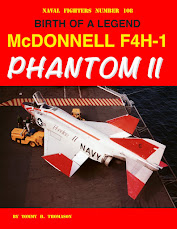7 September 2022: Updated with pictures of the auxiliary flaps. Also see this subsequent post: https://tailspintopics.blogspot.com/2017/01/the-f-111b-auxiliary-flap.html
One of the fixes required of the F-111B for Navy acceptance was restoration of the requisite over-the-nose visibility for carrier landings. It had been accounted for, of course, in the original design.
However, as the overly optimistic empty-weight prediction began to be exceeded, the angle of attack on approach increased and the carrier deck began to be less and less visible to the F-111B pilot. There are three basic ways to restore the required sight picture without going faster on approach: lowering the nose/raising the cockpit, reducing the weight, and increasing lift. All were employed (weight reduction being the hardest to achieve), with the production airplanes after the first two to have a raised cockpit.
Most of the wing-lift changes were introduced in production with F-111A #12 and F-111B #4. (An F-111B span, five-segment flap version of the new wing was evaluated on F-111A #4.) The most obvious was the so-called rotating glove on the inboard fixed section of the wing, shown here on F-111A #4 while it was "armed" with dummy Phoenixes during aerodynamic evaluation of the new wing.
One last lift change was also reportedly introduced on the first two production F-111Bs, the six and seventh built. This was the auxiliary flap, which was located inboard of the existing flaps.
These little flaps were intended to squeeze the last bit of lift out of the existing wing planform. They were electrically driven and controlled by the flap handle. If the pilot selected more than 28 degrees of flap and the wings were swept 16 degrees or less and the wing-sweep handle was set at 16 degrees or less, then the auxiliary flaps would lower. (The 16-degree sweep limitation was driven by the need for clearance of the inboard edge of the auxiliary flap from the side of the fuselage.)
These were reportedly incorporated on the USAF F-111s (its function is described in the F-111A flight manual) and FB-111s as well as the Australian F-111C.
FB-111A photographed by Ron VanDerwarker
This is an inflight picture from below of an Australian F-111 with the auxiliary flap not yet extended (or perhaps locked up).
I've never seen a picture of them on F-111Bs, not even the early production 152714 and 5, but it seems likely that they would have been incorporated on the subsequent F-111Bs along with the raised canopy.
However, on most if not all of the USAF and Australian F-111s (the FB-111A may be an exception) the auxiliary-flap function was reportedly disabled fairly early as being a maintenance burden and not being very effective from a lift standpoint for shore-based operations.















